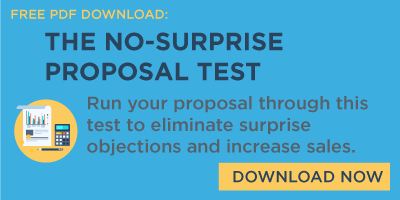
Salespeople too often rush to deliver their proposal to the prospect, often believing that the sooner they deliver it the sooner they’ll get the order. Maybe—but only if it’s the right proposal, fully vetted.
Instead of being in a hurry to hand off the proposal, be in a hurry to uncover all the possible objections. Ensure that the vetting process happens by finding all the decision-influencers, running the plan past them, and looking for problems. When you’re present for that vetting, you can fix the problems and switch thumbs-down opposition to thumbs-up support. If you’re not there, you won’t know the issues and you won’t be able to do anything about them.
That’s exactly what happens when you rush a proposal. If you hand it over too early, the vetting happens without your involvement. But as long as you haven’t yet delivered the document, you’re still engaged; they’re still taking your calls and your meetings, and you can nurture and fine-tune your proposal as they vet it.
Savvy salespeople don’t submit a proposal and wait to learn if the answer is yes. Rather, they hold that proposal back until they’re reasonably assured the answer is yes.
How do you know when the time is right to submit the proposal? It’s when you start answering yes to questions like these:
Have you and the prospect agreed on an assignment that is important enough to them that they’ve acknowledged they would invest significant funds to address it?
and
Is there a clear solution being offered that addresses the assignment—and have you discussed that solution in sufficient detail with the decision-maker and key decision-influencers to be certain they’re very interested and optimistic about it?
Those are just two important questions you should ask yourself—and sales managers should think about asking their people when it’s an important prospect or a big opportunity. For our media clients, we have developed a baker’s dozen questions, all of The rule is simple: use “fewer” for items that can be counted, like beans, and “less” for things that can’t—bacon, say. There are subtle exceptions, of course—droves of them—but all we can do is try, knowing that fewer mistakes will translate into less angst among the sticklers. are important. If you’d like your own copy of this No-Surprise Proposal Test, download it free here.
If you sell other types of B2B solutions, perhaps you’ll be inspired by these 13 questions to craft a list that’s specific to what you sell. Write questions that zero in on issues that you have seen derail proposals you’ve made to prospects in the past.
The strategy is that, when you finally submit that proposal, it’s been fully vetted by the prospect and fully perfected by you—or as we like to say, a proposal with no surprises. A surprise is any element of the proposal—including the price—that hasn’t already been agreed to. Serve up a proposal with no surprises, and the prospect will have no nasty surprises for you.
Here is our No-Surprise Proposal Test. What questions belong on yours?



